First, I would like to say I got this stove for very cheap from http://www.dynamitebuys.com/. I dealt with a gent there by the name of Sean that was very pleasant and customer service oriented. I originally contacted them for an Osburn 2200. It was cheap there versus other sites, but still out of my price range, which was around 1500. I was floored when Sean quoted me a great price on this stove. It was about 300 bucks cheaper than any other site ( at least!! ) and included the gold webbed door, surround, blower etc. I was kind of getting pissed off with other sites that wanted to itemize the doors etc. Anyway, it was shipped via ( free shipping )Estes and made it here 2 days. It was my first time dealing with Estes and those dudes did me right! Good customer service there! Next time im selling something on Ebay that's heavy, I will use them!
Now, to this new beast of a stove I got. First impression out of the crate? Amazing construction. These guys seriously put some work into building this bad boy. I heard someone say that the metal in the firebox was thin, not my impression! They used heavy gauge thick steal everywhere I could touch. The ash lip is cast and the damn door was heavy as hell cast iron. Lets put it this way, I had a Vogelzang Colonial insert that is not as deep but taller and wider than this insert. This puppy out weighs it by 100 pounds WITHOUT the firebrick. Don't believe me? Well im laying down today cause my back is chit after installing this bad boy yesterday. The firebrick in this bastard is heavy duty compared to the zangster! There are special cut concrete pieces around the door and top of back and pumice pieces just to the side of the door. The entire firebox is covered with brick baby! Reminds me of my buddies Clydesdale. I will say this sucker was hell to install. It took me and a drunk friend of mine about 7 hours to install. The liner we ran for the Vogelzang was too long. He cut it once and I told him to stop, but naw, drunk bastard cut it again and we ended up short 8 inches to the cap. The back of the stove is square and the flue collar is straight up instead of angled. We played hell getting the liner into it. But Corrie didn't you guys think about buying an adapter? Hell no! I'm too stupid to do that and my buddy way too damn drunk! It only took about 4 trips on the roof pulling slack out and/or pushing the liner down to give slack for us to get it in. Of course being the gentlemen I am ( afraid of heights ), I let my drunk buddy go up on the roof.
Corrie, hows the burn? Well it's fooking awesome! This stove drafts MUCH better than my Vogelzang. This stove wants to run hot and burn! The secondary tubes created two vortexes of flames in the firebox that is amazing to watch. Only Napoleon and Country Flame utilize this ultra super rare space Nasa technology. It didn't take much wood to get a nice fire going. On my second fire, the top plate of the stove was hitting 700 degrees!! Where as the top corners above the door was around 550. This leads me to my next question, where do I check on this stove for the stoves temp? I am using an IR gun and get quite different results depending where I shoot at. If anyone can chime in, I would appreciate it. Also, just to double check, the fiber board with the edge on one side, the edge is meant to go towards the firebricks to hold them in right? Just checking.
And please tell me after looking at the pics, how did the idiot and bastard drunk do with this install? :lol:
P.S. Wayne if you ever read this thread, thank you so much for helping me out with this stove install. I only ask next time that you dont accidentally let your cigg start a fire in my car again..... That was a scary drive friend.
Now, to this new beast of a stove I got. First impression out of the crate? Amazing construction. These guys seriously put some work into building this bad boy. I heard someone say that the metal in the firebox was thin, not my impression! They used heavy gauge thick steal everywhere I could touch. The ash lip is cast and the damn door was heavy as hell cast iron. Lets put it this way, I had a Vogelzang Colonial insert that is not as deep but taller and wider than this insert. This puppy out weighs it by 100 pounds WITHOUT the firebrick. Don't believe me? Well im laying down today cause my back is chit after installing this bad boy yesterday. The firebrick in this bastard is heavy duty compared to the zangster! There are special cut concrete pieces around the door and top of back and pumice pieces just to the side of the door. The entire firebox is covered with brick baby! Reminds me of my buddies Clydesdale. I will say this sucker was hell to install. It took me and a drunk friend of mine about 7 hours to install. The liner we ran for the Vogelzang was too long. He cut it once and I told him to stop, but naw, drunk bastard cut it again and we ended up short 8 inches to the cap. The back of the stove is square and the flue collar is straight up instead of angled. We played hell getting the liner into it. But Corrie didn't you guys think about buying an adapter? Hell no! I'm too stupid to do that and my buddy way too damn drunk! It only took about 4 trips on the roof pulling slack out and/or pushing the liner down to give slack for us to get it in. Of course being the gentlemen I am ( afraid of heights ), I let my drunk buddy go up on the roof.
Corrie, hows the burn? Well it's fooking awesome! This stove drafts MUCH better than my Vogelzang. This stove wants to run hot and burn! The secondary tubes created two vortexes of flames in the firebox that is amazing to watch. Only Napoleon and Country Flame utilize this ultra super rare space Nasa technology. It didn't take much wood to get a nice fire going. On my second fire, the top plate of the stove was hitting 700 degrees!! Where as the top corners above the door was around 550. This leads me to my next question, where do I check on this stove for the stoves temp? I am using an IR gun and get quite different results depending where I shoot at. If anyone can chime in, I would appreciate it. Also, just to double check, the fiber board with the edge on one side, the edge is meant to go towards the firebricks to hold them in right? Just checking.

And please tell me after looking at the pics, how did the idiot and bastard drunk do with this install? :lol:
P.S. Wayne if you ever read this thread, thank you so much for helping me out with this stove install. I only ask next time that you dont accidentally let your cigg start a fire in my car again..... That was a scary drive friend.


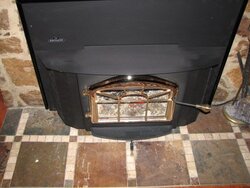
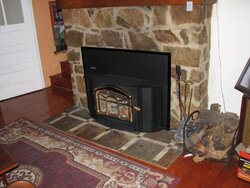
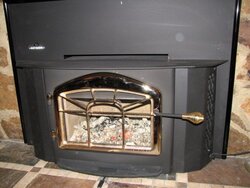
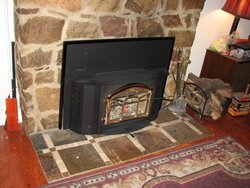
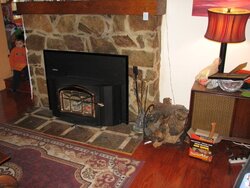
 !
!